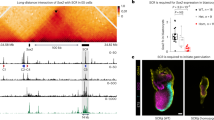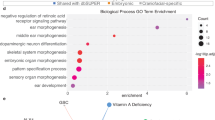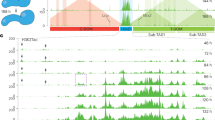Abstract
Mammalian Hox genes are clustered at four genomic loci. During development, neighbouring genes are coordinately regulated by global enhancer sequences, which control multiple genes at once, as exemplified by the expression of series of contiguous Hoxd genes in either limbs or gut. The link between vertebrate Hox gene transcription and their clustered distribution is poorly understood. Experimental and comparative approaches have revealed that various mechanisms, such as gene clustering or global enhancer sequences, might have constrained this genomic organization and stabilized it throughout evolution1,2,3. To understand what restricts the effect of a particular enhancer to a precise set of genes, we generated a loxP/Cre-mediated targeted inversion within the HoxD cluster. Mice carrying the inversion showed a reciprocal re-assignment of the limb versus gut regulatory specificities, suggesting the presence of a silencer element with a unidirectional property. This polar silencer appears to limit the number of genes that respond to one type of regulation and thus indicates how separate regulatory domains may be implemented within intricate gene clusters.
This is a preview of subscription content, access via your institution
Access options
Subscribe to this journal
Receive 12 print issues and online access
$209.00 per year
only $17.42 per issue
Buy this article
- Purchase on Springer Link
- Instant access to full article PDF
Prices may be subject to local taxes which are calculated during checkout






Similar content being viewed by others
References
Duboule, D. Vertebrate Hox gene regulation: clustering and/or colinearity? Curr. Opin. Genet. Dev. 8, 514–518 (1998).
Krumlauf, R. Hox genes in vertebrate development. Cell 78, 191–201 (1994).
Mann, R.S. Why are Hox genes clustered? Bioessays 19, 661–664 (1997).
Kondo, T., Zàkàny, J. & Duboule, D. Control of colinearity in AbdB genes of the mouse HoxD complex. Mol. Cell 1, 289–300 (1998).
Sharpe, J., Nonchev, S., Gould, A., Whiting, J. & Krumlauf, R. Selectivity, sharing and competitive interactions in the regulation of Hoxb genes. EMBO J. 17, 1788–1798 (1998).
Gérard, M. et al. In vivo targeted mutagenesis of a regulatory element required for positioning the Hoxd-11 and Hoxd-10 expression boundaries. Genes Dev. 10, 2326–2334 (1996).
Zàkàny, J. & Duboule, D. Hox genes and the making of sphincters. Nature 401, 761–762 (1999).
Hérault, Y., Beckers, J., Gérard, M. & Duboule, D. Hox gene expression in limbs: colinearity by opposite regulatory controls. Dev. Biol. 208, 157–165 (1999).
Nelson, C.E. et al. Analysis of Hox gene expression in the chick limb bud. Development 122, 1449–1466 (1996).
Zàkàny, J. & Duboule, D. Synpolydactyly in mice with a targeted deficiency in the HoxD complex. Nature 384, 69–71 (1996).
Dupé, V. et al. In vivo functional analysis of the Hoxa-1 3′ retinoic acid response element (3′RARE). Development 124, 399–410 (1997).
Dollé, P. et al. Disruption of the Hoxd-13 gene induces localized heterochrony leading to mice with neotenic limbs. Cell 75, 431–441 (1993).
Davis, A.P. & Capecchi, M.R. A mutational analysis of the 5′ HoxD genes: dissection of genetic interactions during limb development in the mouse. Development 122, 1175–1185 (1996).
van der Hoeven, F., Zàkàny, J. & Duboule, D. Gene transpositions in the HoxD complex reveal a hierarchy of regulatory controls. Cell 85, 1025–1035 (1996).
Kmita, M., van der Hoeven, F., Zàkàny, J., Krumlauf, R. & Duboule, D. Mechanisms of Hox gene colinearity: transposition of the anterior Hoxb1 gene into the posterior HoxD complex. Genes Dev. 14, 198–211 (2000).
Roberts, D.J., Smith, D.M., Goff, D.J. & Tabin, C.J. Epithelial-mesenchymal signaling during the regionalization of the chick gut. Development 125, 2791–2801 (1998).
Peichel, C.L., Prabhakaran, B. & Vogt, T.F. The mouse Ulnaless mutation deregulates posterior HoxD gene expression and alters appendicular patterning. Development 124, 3481–3492 (1997).
Goff, D.J. & Tabin, C.J. Analysis of Hoxd-13 and Hoxd-11 misexpression in chick limb buds reveals that Hox genes affect both bone condensation and growth. Development 124, 627–636 (1997).
Doetschman, T.C., Eistetter, H., Katz, M., Schmidt, W. & Kemler, R. The in vitro development of blastocyst-derived embryonic stem cell lines: formation of visceral yolk sac, blood islands and myocardium. J. Embryol. Exp. Morphol. 87, 27–45 (1985).
Acknowledgements
We thank M. Friedli for technical assistance; members of the laboratory for comments and reagents; and M. Levine for comments. This work was supported by funds from the Canton de Genève, the Swiss National Research Fund, the Claraz, Latsis, Cloetta and Louis-Jeantet foundations.
Author information
Authors and Affiliations
Corresponding author
Rights and permissions
About this article
Cite this article
Kmita, M., Kondo, T. & Duboule, D. Targeted inversion of a polar silencer within the HoxD complex re-allocates domains of enhancer sharing. Nat Genet 26, 451–454 (2000). https://doi.org/10.1038/82593
Received:
Accepted:
Issue Date:
DOI: https://doi.org/10.1038/82593
This article is cited by
-
CRISPR/Cas9 and FLP-FRT mediated regulatory dissection of the BX-C of Drosophila melanogaster
Chromosome Research (2023)
-
HOX13-dependent chromatin accessibility underlies the transition towards the digit development program
Nature Communications (2020)
-
Evolution of Hoxa11 regulation in vertebrates is linked to the pentadactyl state
Nature (2016)
-
Epigenetic regulations in hematopoietic Hox code
Oncogene (2011)
-
Genetically modified mouse models in cancer studies
Clinical and Translational Oncology (2008)



